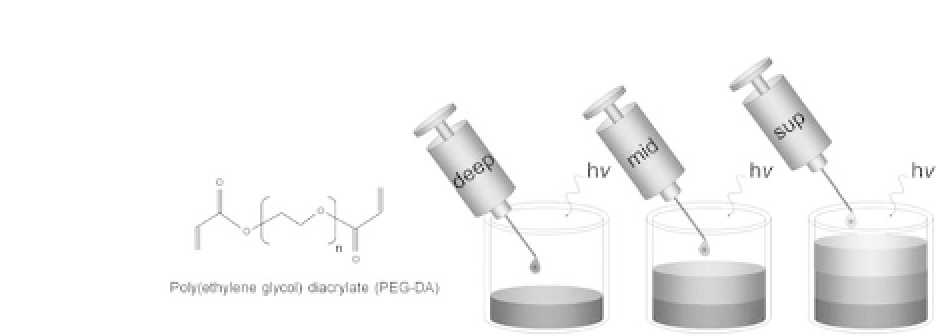Biomedical Engineering Reference
In-Depth Information
Figure 36.6.
PEG-DA, when combined in solution with a photoinitiator,
can be photopolymerized using ultraviolet light to form a hydrogel. Kim
et
al
. encapsulated chondrocytes from different zones in the PEG-DA solution
andsequentiallyphotopolymerizedthelayerstoformzonalconstructswith
biomimeticcellular organization.
80
Interestingly, in another study, bilayered constructs attained higher
compressive and shear moduli than homogeneous constructs, indi-
cating potential synergistic effects ofthe co-culture conditions.
81
PEG hydrogels using different polymerization approaches are
alsoavailableandhavepotentialintheseareas.Onesuchgelsystem
forms by disulfinde bonding between multiarm PEG-vinyl sulfone
and cysteines of synthetic peptides or proteins.
82
Gels form within
10 minutes after combining the precursor solutions using this sys-
tem,anditisamenabletoinjectabledelivery.Thesystemisquite
versatile, given the variety of peptides that can be designed and
incorporated into the gel. For example, a matrix metalloproteinase
(MMP)-sensitive sequence was used to make the hydrogel specifi-
cally degradable (instead of hydrolytically) and showed effects on
chondrocyte proliferation, collagen network formation, and gene
expression.
82
Multiple functionalities (such as cell adhesivity) can be incor-
porated by adding different cysteine-containing peptides.
83
The
mechanical properties can be controlled by the macromer content
and number of arms on the starting PEG, and clearly tailoring the
degradability has an influence on the mechanical properties of the
final tissue. While these gels have not been used to form zonal car-
tilage constructs, differences observed using chondrocytes in this








Search WWH ::

Custom Search